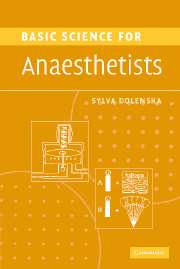Book contents
- Frontmatter
- Contents
- List of abbreviations and symbols
- List of figure captions
- Forewords
- Preface
- Preface to the second edition
- Part 1 Physics, mathematics, statistics, anaesthetic apparatus
- 1 Gas compression, relationship of volume, pressure and temperature
- 2 Real gas compression
- 3 Flow and resistance
- 4 Heat, vaporization and humidification
- 5 Simple mechanics 1: mass, force, pressure
- 6 Simple mechanics 2: work and power
- 7 Mathematical concepts
- 8 Exponentials 1: the curves
- 9 Exponentials 2: properties of exponential decay curve
- 10 Descriptive statistics
- 11 Presentation of data
- 12 Receiver operating characteristic curve
- 13 Gas supply and pressure
- 14 The circle system
- 15 The Mapleson A (Magill) breathing system
- 16 T-pieces
- 17 Lung filling with automatic lung ventilators
- Part 2 Clinical measurement
- Part 3a Physiology: the cardiovascular system
- Part 3b Physiology: the respiratory system
- Part 4 Pharmacology
- Further Reading
- Index
4 - Heat, vaporization and humidification
from Part 1 - Physics, mathematics, statistics, anaesthetic apparatus
Published online by Cambridge University Press: 13 August 2009
- Frontmatter
- Contents
- List of abbreviations and symbols
- List of figure captions
- Forewords
- Preface
- Preface to the second edition
- Part 1 Physics, mathematics, statistics, anaesthetic apparatus
- 1 Gas compression, relationship of volume, pressure and temperature
- 2 Real gas compression
- 3 Flow and resistance
- 4 Heat, vaporization and humidification
- 5 Simple mechanics 1: mass, force, pressure
- 6 Simple mechanics 2: work and power
- 7 Mathematical concepts
- 8 Exponentials 1: the curves
- 9 Exponentials 2: properties of exponential decay curve
- 10 Descriptive statistics
- 11 Presentation of data
- 12 Receiver operating characteristic curve
- 13 Gas supply and pressure
- 14 The circle system
- 15 The Mapleson A (Magill) breathing system
- 16 T-pieces
- 17 Lung filling with automatic lung ventilators
- Part 2 Clinical measurement
- Part 3a Physiology: the cardiovascular system
- Part 3b Physiology: the respiratory system
- Part 4 Pharmacology
- Further Reading
- Index
Summary
Heat is one form of energy; temperature is a measure of the random thermal movement of molecules or atoms (the thermal state of a substance).
Physical changes occur in substances when their temperature is changed by the addition or removal of heat. These are due to increased or reduced thermal movement of molecules.
With progressive addition of heat, change of phase happens (from solid to liquid, from liquid to vapour) as cohesive forces are overcome by random thermal movement. The heat necessary to overcome the cohesive forces during change of phase is called latent heat. According to the first law of thermodynamics, substances with a higher temperature (higher thermal state) will pass their heat onto substances with a lower temperature (lower thermal state). Accordingly, to convert a substance from one phase into another, latent heat must be supplied or removed.
Specific latent heat refers to 1 kg of a substance converted from one phase to another at a constant temperature. Temperature and substance must be stated as specific latent heat is temperature-dependent, and each substance has different thermal properties. Water is a liquid at 0 ℃ and vaporizes at 100 ℃ at atmospheric pressure (see Figure 10). At higher pressures it would vaporize at higher temperatures, until it reached its critical temperature (data not shown); at this point the specific latent heat is zero. Nitrous oxide is a gas at atmospheric pressure; it must be compressed to liquefy.
- Type
- Chapter
- Information
- Basic Science for Anaesthetists , pp. 14 - 17Publisher: Cambridge University PressPrint publication year: 2006



